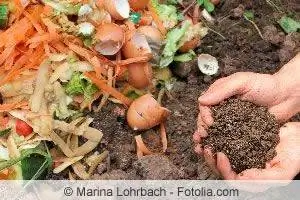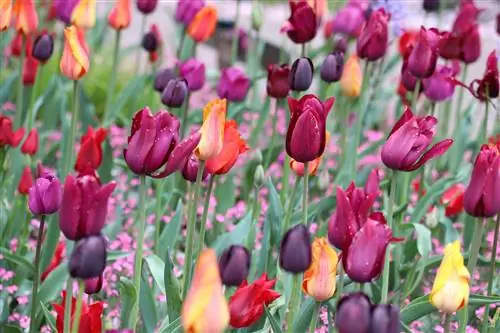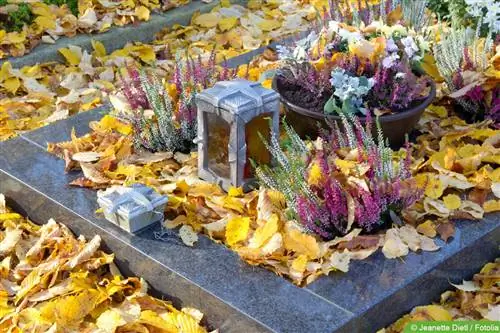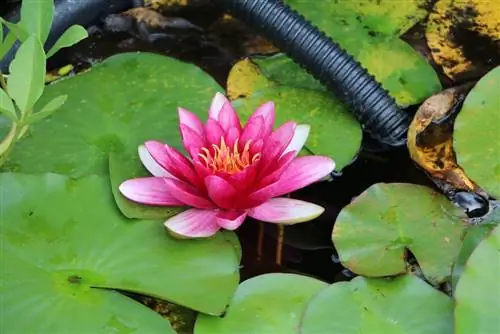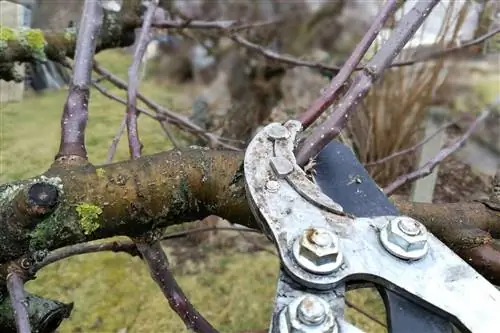- Author admin [email protected].
- Public 2023-12-17 03:39.
- Last modified 2025-01-24 12:45.
It's humming and chirping in your own garden, maybe a few frogs are croaking. This can be pure relaxation for nature lovers. And it's not that difficult to design such a natural garden yourself. A little know-how about what goes into an organic garden and you can start creating it. However, designing a natural garden does not mean that it languishes unkempt. A little care and the flower meadow, the pond or the natural stone wall will come into their own beautifully.
Create a flower meadow
The most important thing in a natural garden is a flower meadow. Well-kept, English lawn has no place here. But even a flower meadow must be designed according to your own wishes. The advantages here are of course obvious, because the many blooming flowers attract bees and bumblebees. This is how the flower meadow can be easily achieved with a little help from the hobby gardener:
- Many flowers require nutrient-poor soil, otherwise the grasses will prevail
- In the first step before sowing, mow the meadow less and not too deeply, do not fertilize
- possibly mix sand into the soil
- Remove all grass clippings, otherwise they will act as fertilizer again
- Use seed mixtures for meadow flowers from the trade
- pay attention to the desired location
- ideally choose mixtures that occur in local latitudes
- spread generously over the entire meadow
- also think about spring and plant flower bulbs in many places in autumn
- Crocus, daffodils, lily of the valley or even small tulip species are suitable for this
- Watering the meadow in hot, dry summers
- otherwise the naturally falling rain is completely sufficient
- next year new flowers will grow from the seeds formed
- the first flowers appear, no more mowing the meadow
Tip:
Choose different flowering times for the meadow flowers for the seed mixtures. This ensures flowering from spring until well into autumn.
Compost
Of course, every natural garden also needs compost. Kitchen waste, old leaves, grass cuttings or even chopped wood cuttings can be disposed of here. These make good fertilizer for the kitchen garden. But simply throwing everything together doesn't make good compost. Therefore, you should definitely pay attention to the following:
- the compost must not be too dry or too wet
- fermentation of waste should definitely be avoided
- this is achieved through good air circulation
- therefore layer wet waste, such as old leaves, kitchen scraps or grass clippings with chopped wood cuttings
- Create compost on a well-drained soil
- If the soil is impermeable, create a drainage system under the compost in advance, for example made of sand
- The ideal location for the compost is sheltered from the wind and partially shaded
- so it doesn't dry out
- because drying out or too much moisture prevents the animals and organisms useful for the compost from settling
- You can quickly build a compost container yourself from a few slats, make sure there is enough air supply on the sides
Tip:
If you don't want to make your own compost, you can get a ready-made container from a specialist retailer.
Garden pond
A pond in a large garden is a beautiful eye-catcher and a paradise for other animals, such as frogs or toads. But fish should be avoided because then ecological balance cannot be achieved. Mosquitoes are not a problem; they are needed as food by dragonflies or other larger insects. The pond is rounded off with water lilies in the water and various plants on the bank, such as marsh marigold, globe flower or iris. If you don't have space for a garden pond, you can also set up a wooden barrel in a corner as a miniature pond.
Tip:
If there are small children in the family, you should initially avoid building a garden pond because in such a case it could pose a greater danger to the children.
Create niches
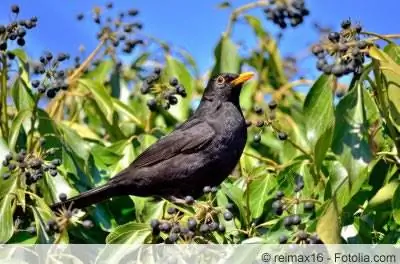
An eco-garden not only needs lots of beautiful flowers, niches should also be created for the animals in the garden. If you have the courage to add a little wilderness to your natural garden, you can create valuable niches for nature using simple means such as stones, dead wood or brushwood:
- leave old fruit trees standing, even if they bear little or no fruit anymore
- They are well suited to their tree hollows as nesting places for various types of birds
- These include sparrows, nuthatches, tits, redstarts and starlings
- Insects also like to live in dead wood
- to stack a stack of dead wood decoratively in a corner of the eco-garden
- Toads, shrews and hedgehogs are particularly happy about the insect inhabitants
- Wrens or robins, on the other hand, like to inhabit piles of brushwood
Tip:
The good thing about these garden companions is that they keep annoying pests away from a kitchen garden. For example, hedgehogs eat slugs.
Creating a dry stone wall
Especially in very sunny places in the organic garden, it is a good idea to build a wall made of natural stones in which drought-loving plants can then be cultivated. Salamanders or lizards that love warm stones are also attracted to such a wall. The wall can be built as follows:
- except sandstone, which weathers too quickly, all natural stones are suitable
- also suitable as a support for a higher bed
- choose a solid surface
- build narrower from bottom to top
- pay attention to small joints, possibly insert small stones
- Always place stones in gaps so that no vertical joints are created
- leave out niches during construction where plants will be placed
- Plant plants such as the small soapwort, the blood-red cranesbill or the Whitsun carnation in the niches
- insert with a little water and compost
Tip:
Bumblebees or wild bees, which like to hide in the warm holes, are also attracted to a dry stone wall
Nest boxes
Nest boxes are not only useful for many domestic birds that find a breeding place in them. Beneficial insects such as bees or bumblebees also like to use such a box as an insect hotel. Therefore, many such nesting boxes can be distributed in the natural garden. However, if insects are to move in, care must be taken to ensure that birds cannot fit through the entry holes provided. Otherwise, the bees or bumblebees will be left behind if a sparrow has already built its nest there.
Conclusion
If you want to create a natural garden, you can turn your garden into an ecological paradise for many native birds, insects and other small animals, such as hedgehogs, frogs or salamanders. Watching these from the terrace will be a lot of fun for young and old alike. Likewise the variety of flowers that can arise in a natural meadow. In this way, the ecological balance can be maintained with little effort even in the city.

